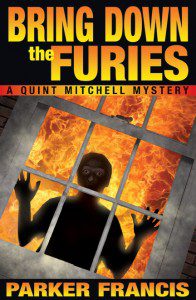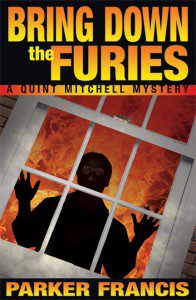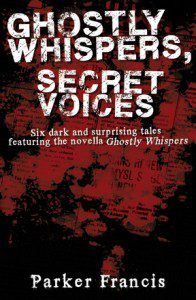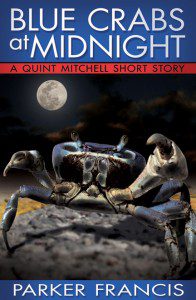The following first appeared in The Florida Writer, the official member magazine of the Florida Writers Association, in my column, The First Million Words.
“I had to force myself to finish it.”
The speaker was a woman I met at a party recently, and she was telling me of a book she’d read that hadn’t held her attention. Gratified to learn it wasn’t one of my books, I began thinking about the difference between the book she had read, and others where the reader just couldn’t put it down. My guess is her book lacked suspense, a key ingredient separating a so-so book from a compelling one.
All novels, no matter what genre, should have a climate of suspense to hold the reader’s interest. Unlike tension (a topic I’ll address in my next column), which comes in sharp, surprising bursts guaranteed to ramp up the adrenaline, suspense should be present from the very first page. Think about some of these opening lines”
“My name was Salmon, like the fish; first name Susie. I was fourteen when I was murdered on December 6, 1973.”
This opening from The Lovely Bones by Alice Sebold grabs the reader’s attention, piques their curiosity and injects a healthy dose of suspense. How about this one:
“When he was nearly thirteen, my brother Jem got his arm badly broken at the elbow. When enough years had gone by to enable us to look back on them, we sometimes discussed the events leading to his accident.”
You probably recognize this classic. It’s the opening from To Kill A Mockingbird. Scout Finch teases the reader with this intriguing bit of information about her brother before moving on to describe her little town of Maycomb, Alabama. It isn’t until the very end of the book that Scout tells us about the incident leading to Jem’s broken arm. Author Harper Lee heaped on a healthy serving of suspense leaving the reader craving more information.
You can have memorable characters, snappy dialogue and a unique setting, but if you don’t grab the reader’s attention quickly they may search for another story with more suspense. The trick is to arouse the reader’s curiosity and keep it aroused for as long as possible. All of this adds to a book’s narrative drive, a special blend of pace and style forcing the story forward, adding an element of anticipation. In other words—suspense.
One common way to build suspense into your story is what I call The Bait and Switch Technique. We see this all the time. The author builds toward a dramatic point in the story, extending the action, ramping up the tension and right before the climactic moment when the real killer is exposed, or the meaning of the cryptic note explained, the author jumps to another plotline, typically changing point of view and location.
 In Alex Grecian’s historical thriller, The Yard, Inspector Walter Day searches for a serial killer in one of London’s deplorable workhouses. At the end of the chapter, he’s warned that the man with the scissors (the killer) is right behind him. The reader is expecting a ferocious battle between the protagonist and the antagonist, but Grecian leaves the reader in suspense while he deals with another crisis situation. And do we see how Inspector Day is faring after that chapter? We do not. Instead the reader is transported to a third dramatic situation. All the while we’re kept in suspense about the fate of brave Inspector Day.
In Alex Grecian’s historical thriller, The Yard, Inspector Walter Day searches for a serial killer in one of London’s deplorable workhouses. At the end of the chapter, he’s warned that the man with the scissors (the killer) is right behind him. The reader is expecting a ferocious battle between the protagonist and the antagonist, but Grecian leaves the reader in suspense while he deals with another crisis situation. And do we see how Inspector Day is faring after that chapter? We do not. Instead the reader is transported to a third dramatic situation. All the while we’re kept in suspense about the fate of brave Inspector Day.
Thomas Harris did the same in Silence of the Lambs when the crazed killer decides he’s going to harvest the  senator’s daughter. Chapter 46 ends with Buffalo Bill outlining his graphic plans for the girl and informs the reader of his intentions to do the deed the next day. All of this advances the ticking clock deadline and builds suspense. But instead of satisfying the reader’s hunger for resolution by starting chapter 47 with the killer and his intended victim, Harris cuts back to Clarice Starling and then to her boss, Jack Crawford. And by the time we return to the killer, in chapter 48, there are even more complications since the senator’s daughter has somehow trapped Buffalo Bill’s beloved little dog and is threatening to kill it.
senator’s daughter. Chapter 46 ends with Buffalo Bill outlining his graphic plans for the girl and informs the reader of his intentions to do the deed the next day. All of this advances the ticking clock deadline and builds suspense. But instead of satisfying the reader’s hunger for resolution by starting chapter 47 with the killer and his intended victim, Harris cuts back to Clarice Starling and then to her boss, Jack Crawford. And by the time we return to the killer, in chapter 48, there are even more complications since the senator’s daughter has somehow trapped Buffalo Bill’s beloved little dog and is threatening to kill it.
So you see that bit-by-bit, drop-by-drop, the author squeezes out all the tension he can, building the suspense to torturous levels before allowing the reader the catharsis of the climax. Bait & Switch is  more difficult to pull off effectively if you’re using a first person POV, as in my Quint Mitchell Mystery series. In Bring Down the Furies, I attempted to add more suspense by cutting away at key moments by inserting an anonymous diary entry as a device to break the action. I ended chapter 14 with Quint waking to see smoke seeping into his room. I wanted to build the suspense as much as possible before continuing with Quint’s dilemma, but first person typically locks us into a single POV. I cheated a bit and used the diary entry for that purpose. The diary was tied to the story’s main mystery, but I wrote it as a provocative introduction to an unnamed character who played a big part in the resolution of the mystery. I inserted a different diary entry three or four times within the story, offering few clues to the writer’s identity and, hopefully, adding more suspense to the story.
more difficult to pull off effectively if you’re using a first person POV, as in my Quint Mitchell Mystery series. In Bring Down the Furies, I attempted to add more suspense by cutting away at key moments by inserting an anonymous diary entry as a device to break the action. I ended chapter 14 with Quint waking to see smoke seeping into his room. I wanted to build the suspense as much as possible before continuing with Quint’s dilemma, but first person typically locks us into a single POV. I cheated a bit and used the diary entry for that purpose. The diary was tied to the story’s main mystery, but I wrote it as a provocative introduction to an unnamed character who played a big part in the resolution of the mystery. I inserted a different diary entry three or four times within the story, offering few clues to the writer’s identity and, hopefully, adding more suspense to the story.
Here are a few more ways to add suspense to key scenes. Instead of jumping right into the action, you extend the scene by making the character hyper-aware of his surroundings, of the smells and sounds, the feel of the breeze on his face, the birds in the tree. This ratchets up the suspense and adds to the feeling of impending danger.
Don’t forget to use your character’s emotions and insecurities as a way to heighten suspense. The more she worries about the forthcoming event, the more suspenseful it will be when it finally arrives. So get inside your character’s head. How does she feel during these tense moments? Lump in her throat? Pulse pounding? Sweaty? Make the reader feel what the character is feeling.
Placing your hero at a disadvantage always adds to the suspense as the reader wonders how she’ll cope with the new problems you’ve heaped upon her. So think of ways to make more trouble for your protagonist, thwart her at every turn. Take away her support systems. Cast doubts on her friends and allies. Keep the internal conflicts roiling as she faces one challenge after another.
And there has to be a payoff after you’ve built a suspenseful scene. Maybe it leads to a major plot twist at the end of Act One or Two. Maybe it’s the discovery of a body or finding an important clue.
If you’ve made your readers care about your character, created a high level of anticipation, constantly building toward the climax, then you will have gone a long way toward injecting enough suspense to satisfy the reader.
Try it. The suspense won’t kill you.
_______________________________________________________________________________
Look for Parker’s suspense-filled stories.



